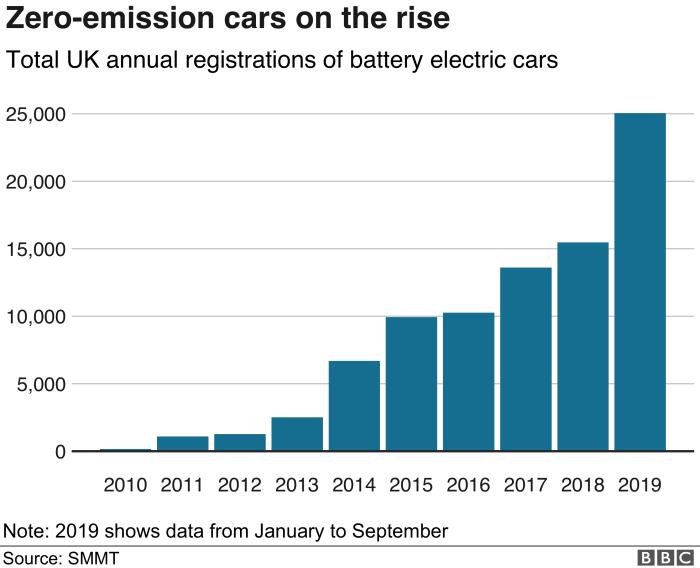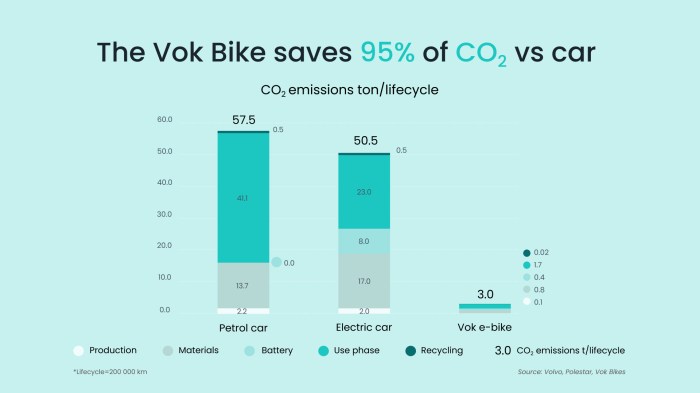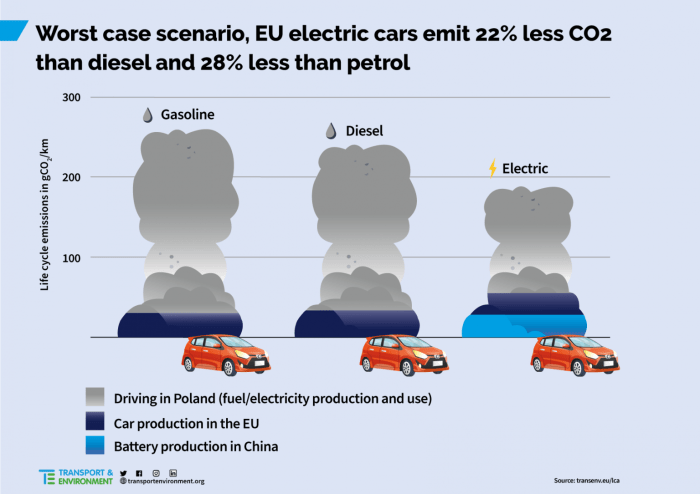Carbon footprint of EVs vs gas cars 2025 – Carbon footprint of EVs vs gas cars 2025: So, you’re thinking about going electric, huh? Smart move, environmentally speaking, right? But is it
-really* greener than sticking with your trusty gas guzzler? It’s way more complicated than just plugging in versus filling up. We’re diving deep into the whole lifecycle – from mining the materials to scrapping the car – to see which really wins in the 2025 emissions showdown.
This report breaks down the environmental impact of electric vehicles (EVs) and gasoline-powered cars, focusing on their entire life cycle. We’ll compare manufacturing processes, electricity source impacts, operational emissions, and end-of-life considerations, all using the latest data available for 2025. Get ready for some surprising insights into the true cost – environmentally speaking – of getting from point A to point B.
Manufacturing Phase Comparison: Carbon Footprint Of EVs Vs Gas Cars 2025

The manufacturing process for both electric vehicles (EVs) and internal combustion engine (ICE) vehicles significantly impacts their overall carbon footprint. While EVs are often touted as cleaner, the energy-intensive battery production presents a considerable challenge. A comprehensive comparison requires examining the energy consumption and emissions across the entire supply chain, from raw material extraction to final assembly.The production of EV batteries and ICE vehicles involves distinct materials and processes, each with its own environmental footprint.
EV batteries demand significant quantities of lithium, cobalt, nickel, and manganese, all requiring extensive mining and refining. ICE vehicles, conversely, rely heavily on steel, aluminum, and plastics, whose production also contributes to greenhouse gas emissions.
Energy Consumption and Emissions in Battery vs. ICE Vehicle Production
Manufacturing EV batteries is significantly more energy-intensive than producing the equivalent components for an ICE vehicle. The process includes mining and refining raw materials, cell manufacturing, battery pack assembly, and testing. Each step consumes substantial energy, often derived from fossil fuels, leading to considerable CO2 emissions. In contrast, ICE vehicle production, while still energy-intensive, generally involves less complex processes and fewer rare earth materials.
However, the manufacturing of steel and aluminum, key components of ICE vehicles, is also energy-intensive and a major source of emissions.
Carbon Footprint of Raw Material Sourcing
Sourcing raw materials for both EV and ICE vehicle production carries a significant environmental cost. Lithium mining, for instance, is known for its water consumption and potential for habitat destruction. Cobalt mining is often associated with human rights concerns and environmental damage in some regions. The extraction and refining of nickel and manganese also contribute to greenhouse gas emissions and pollution.
Similarly, steel and aluminum production, essential for ICE vehicles, are energy-intensive processes that release substantial amounts of CO2 into the atmosphere. The environmental impact varies depending on the mining practices and energy sources employed in the process. For example, using renewable energy sources in the refining process can significantly reduce the carbon footprint.
Manufacturing Carbon Footprint Comparison (2025 Estimates)
The following table provides estimated data for the manufacturing carbon footprint of a representative EV and a comparable ICE vehicle in 2025. Note that these figures vary depending on vehicle size, battery chemistry, manufacturing processes, and regional variations in energy sources. These figures represent average estimates based on available data from various reputable sources, and further research is needed for precise figures.
| Vehicle Type | Stage of Production | CO2 Emissions (kg) | Energy Consumption (kWh) |
|---|---|---|---|
| Electric Vehicle (Mid-size Sedan) | Raw Material Extraction | 5000 | 10000 |
| Electric Vehicle (Mid-size Sedan) | Battery Manufacturing | 7000 | 15000 |
| Electric Vehicle (Mid-size Sedan) | Vehicle Assembly | 2000 | 4000 |
| Internal Combustion Engine Vehicle (Mid-size Sedan) | Raw Material Extraction | 3000 | 6000 |
| Internal Combustion Engine Vehicle (Mid-size Sedan) | Component Manufacturing | 4000 | 8000 |
| Internal Combustion Engine Vehicle (Mid-size Sedan) | Vehicle Assembly | 3000 | 6000 |
Electricity Source Impact on EV Footprint

The environmental benefits of electric vehicles (EVs) are significantly tied to the cleanliness of the electricity used to charge them. While EVs produce zero tailpipe emissions, the electricity generation process itself can contribute substantially to their overall carbon footprint. This means that an EV charged primarily with renewable energy will have a far smaller environmental impact than one powered by a grid heavily reliant on fossil fuels.
The location where the EV is charged dramatically affects its environmental profile.The carbon intensity of electricity grids varies widely across regions and countries, primarily due to differences in the energy mix used for power generation. Regions with a high percentage of coal-fired power plants will have a much higher carbon intensity compared to those predominantly using renewable sources like solar, wind, or hydro.
Nuclear power, while not emitting greenhouse gases during operation, carries its own set of environmental concerns related to waste disposal and potential accidents. Therefore, understanding the regional electricity mix is crucial for accurately assessing the true environmental impact of EVs.
Regional Variations in Electricity Sources and EV Emissions
The impact of electricity source on EV emissions is stark. For example, an EV charged in a state with a high reliance on coal-fired power plants, like some parts of the Appalachian region, will have a significantly larger carbon footprint compared to an EV charged in a state with a high proportion of renewable energy sources, such as California or several states in the Pacific Northwest.
In states with significant hydropower, the carbon footprint of charging an EV is even lower. This highlights the importance of considering regional electricity mixes when evaluating the overall environmental performance of EVs.
Hypothetical Scenario: Coal vs. Renewable Energy
Let’s imagine two identical EVs, both driven for 100,000 miles over their lifespan. EV A is charged exclusively using electricity from a grid where 80% of electricity comes from coal-fired power plants (high carbon intensity). EV B is charged using electricity from a grid powered by 80% renewable energy sources (low carbon intensity). We’ll use a simplified methodology assuming a constant electricity consumption rate for both vehicles.
To estimate the emissions, we would multiply the vehicle’s total energy consumption (kWh) over its lifetime by the carbon intensity of the respective electricity grids (grams of CO2e per kWh). This will yield a total CO2e emission for each EV. EV A, charged with coal-heavy electricity, will have considerably higher lifetime emissions than EV B, which benefits from a cleaner energy source.
Real-world scenarios would involve more complex calculations, accounting for variations in driving patterns, charging efficiency, and the changing electricity mix over time. However, this hypothetical example clearly illustrates the significant impact of the electricity source on the overall carbon footprint.
So, you’re thinking about switching to an EV in 2025? That’s awesome, but you should also consider the whole picture of its environmental impact compared to gas cars. Part of that equation is ensuring you’re prepared for all weather conditions, which is why knowing about the best tires for your EV is crucial. Check out this guide on Best EV tires for snow and ice 2025 to stay safe and maximize your EV’s efficiency.
Ultimately, a well-equipped EV can really minimize your carbon footprint.
Improvements in Grid Infrastructure and Renewable Energy Adoption
Significant improvements in grid infrastructure and a wider adoption of renewable energy sources are key to reducing the carbon footprint of EV usage. Investing in smart grids that can better integrate renewable energy sources like solar and wind power, and improving energy storage solutions, are crucial steps. Furthermore, large-scale deployment of renewable energy generation capacity (solar farms, wind farms, etc.) will drastically lower the carbon intensity of electricity grids.
Debating the carbon footprint of EVs vs. gas cars in 2025? It’s a complex issue, factoring in manufacturing, electricity sources, and vehicle lifespan. But keeping your EV running smoothly is key to minimizing its overall impact; that’s where convenient services like Mobile EV repair services near me come in handy. Regular maintenance ensures optimal performance and longevity, ultimately contributing to a smaller carbon footprint over the long haul.
Policies promoting renewable energy development and carbon pricing mechanisms also play a vital role in incentivizing cleaner electricity generation. The transition to a more sustainable electricity grid is not just beneficial for EVs; it offers broader environmental and economic benefits.
Operational Phase Emissions
The operational phase, encompassing the vehicle’s use throughout its lifespan, significantly impacts its overall carbon footprint. While manufacturing and battery sourcing contribute substantially to the initial environmental burden, the ongoing emissions from driving represent a considerable portion, particularly over the vehicle’s longer-term use. This section compares the operational emissions of gasoline cars and EVs, considering the crucial role of electricity sources.
Gasoline-powered vehicles directly release greenhouse gases through their tailpipes, primarily carbon dioxide (CO2), but also including methane (CH4) and nitrous oxide (N2O). Electric vehicles, on the other hand, produce zero tailpipe emissions. However, their operational emissions are indirectly tied to the generation of the electricity used to charge their batteries. This means the “cleanliness” of an EV’s operation depends heavily on the energy mix of the power grid supplying the charging station.
Tailpipe Emissions Comparison
A direct comparison reveals a stark difference. Gasoline cars release CO2 directly proportional to their fuel consumption and the carbon intensity of the gasoline. EVs, in contrast, have no direct tailpipe emissions. The operational emissions of an EV are instead a function of the electricity source used to charge its battery. For instance, an EV charged primarily with renewable energy sources (solar, wind) will have significantly lower operational emissions compared to one charged with electricity generated from coal-fired power plants.
- Gasoline cars: Produce significant tailpipe emissions of CO2, CH4, and N2O.
- Electric vehicles: Produce zero tailpipe emissions; operational emissions are determined by the electricity source used for charging.
Factors Influencing EV Operational Carbon Footprint
Several factors influence the operational carbon footprint of EVs beyond the electricity source. These factors affect the energy consumption of the vehicle and, consequently, the amount of electricity required for operation. Understanding these factors is crucial for accurately assessing an EV’s environmental impact.
- Driving style: Aggressive driving, frequent acceleration and braking, significantly increases energy consumption and thus the carbon footprint.
- Vehicle efficiency: EVs with higher efficiency (measured in miles per kilowatt-hour or MPKWh) require less energy for the same distance traveled, leading to lower emissions.
- Terrain and weather conditions: Driving uphill or in cold weather increases energy consumption due to increased resistance.
- Tire pressure: Properly inflated tires reduce rolling resistance, improving efficiency and lowering energy consumption.
Battery Degradation and Replacement Impact
Battery degradation is an unavoidable aspect of EV ownership. Over time, battery capacity diminishes, reducing the vehicle’s range and potentially increasing energy consumption per mile. Eventually, battery replacement becomes necessary. The manufacturing and disposal of EV batteries contribute to the overall lifecycle emissions of the vehicle. The environmental impact of battery replacement is significant and must be considered when evaluating the total lifecycle emissions of an EV.
For example, a study by the International Energy Agency (IEA) suggests that battery production accounts for a significant portion of an EV’s total carbon footprint, and that the carbon intensity of battery production varies greatly depending on the manufacturing processes and the sourcing of raw materials. The replacement of a degraded battery introduces a substantial new carbon footprint, which needs to be factored into the long-term assessment.
Moreover, the end-of-life management of spent batteries is critical to minimize environmental impact, requiring efficient recycling and responsible disposal processes.
End-of-Life Considerations
The end-of-life phase of both electric vehicles (EVs) and internal combustion engine (ICE) vehicles presents unique environmental challenges and opportunities. While ICE vehicles primarily involve the disposal or recycling of various metal components and fluids, EVs introduce the complexities of battery recycling and the responsible management of other specialized materials. Understanding the environmental impact of these processes is crucial for a complete lifecycle assessment of each vehicle type.EV batteries, unlike many ICE components, contain valuable and potentially hazardous materials.
Their proper management is paramount to minimizing environmental damage and maximizing resource recovery. ICE vehicles, on the other hand, while containing recyclable materials, also generate significant waste streams that can pose environmental risks if not handled properly.
Comparison of EV Battery and ICE Vehicle Component Recycling
The recycling and disposal processes for EV batteries and ICE vehicle components differ significantly, resulting in varying environmental impacts. The following table summarizes these differences:
| Process | EV Battery Recycling | ICE Vehicle Component Recycling |
|---|---|---|
| Material Recovery | Complex process involving dismantling, separating, and recovering valuable materials like lithium, cobalt, nickel, and manganese. Often involves hydrometallurgical or pyrometallurgical processes. | Relatively simpler process focusing on recovering ferrous and non-ferrous metals, plastics, and glass. Often involves shredding and separation techniques. |
| Emissions | Emissions vary depending on the recycling method used. Hydrometallurgical processes generally have lower emissions than pyrometallurgical processes, but both can release greenhouse gases and air pollutants. | Emissions primarily from transportation to recycling facilities, shredding processes, and potential air pollution from burning or incineration of non-recyclable materials. |
| Energy Consumption | Higher energy consumption due to the complexity of the battery dismantling and material separation processes. | Lower energy consumption compared to EV battery recycling. |
| Environmental Risks | Potential for soil and water contamination from leaching of heavy metals if not handled properly. | Potential for soil and water contamination from leaching of heavy metals from certain components, and air pollution from incineration. |
Challenges and Opportunities in Responsible Battery Recycling, Carbon footprint of EVs vs gas cars 2025
Responsible battery recycling faces several challenges, including the development of efficient and cost-effective recycling technologies, the establishment of robust regulatory frameworks to ensure proper handling of hazardous materials, and the need for infrastructure development to support large-scale recycling operations. However, there are significant opportunities as well. The recovery of valuable materials from EV batteries can reduce reliance on mining new materials, lowering the environmental impact of battery production and reducing geopolitical dependencies on specific mineral-rich regions.
Technological advancements in battery chemistry, such as the development of more easily recyclable battery designs, also promise to improve the efficiency and sustainability of battery recycling. For example, the use of less toxic materials and modular battery designs can simplify the recycling process and minimize environmental risks. Companies like Redwood Materials are actively working on scaling up their battery recycling operations, demonstrating the growing interest and investment in this sector.
Environmental Impact of Battery Material Mining and Processing
The mining and processing of raw materials required for EV batteries, such as lithium, cobalt, and nickel, have significant environmental impacts. Mining activities can lead to habitat destruction, water pollution, and greenhouse gas emissions. The processing of these materials also requires substantial energy and can generate air and water pollution. For example, lithium mining, often associated with brine extraction, can deplete water resources and impact local ecosystems.
Cobalt mining, often carried out in challenging conditions with potential for human rights abuses, also raises significant environmental and social concerns. The environmental impact of mining and processing is not limited to the initial production; replacement batteries throughout the EV lifespan will continue to contribute to this environmental burden. The need for responsible sourcing of materials and the development of more sustainable mining and processing techniques are crucial for mitigating these impacts.
This includes investing in closed-loop recycling systems, where materials from recycled batteries are directly used in new battery production, minimizing the reliance on newly mined resources.
Lifecycle Assessment Methodology
Figuring out the true environmental impact of a car – whether it’s gas-powered or electric – isn’t as simple as just looking at tailpipe emissions. We need a lifecycle assessment (LCA) to get the full picture, considering everything from raw material extraction to end-of-life disposal. Different LCA methodologies exist, each with its own strengths and weaknesses.Different methodologies exist for assessing the lifecycle carbon footprint of vehicles, each offering unique perspectives and challenges.
These methods vary in their scope, data requirements, and the level of detail they provide. Understanding these differences is crucial for interpreting the results of various studies.
LCA Methodologies and Their Characteristics
Several approaches exist for conducting LCAs, each with its own advantages and limitations. Common methods include attributional LCA and consequential LCA. Attributional LCA focuses on the average environmental impact associated with a specific product’s production and use, while consequential LCA considers the broader ripple effects of a product’s introduction on the entire system, such as changes in electricity generation.
For example, an attributional LCA might assess the carbon emissions from a specific battery manufacturing plant, while a consequential LCA would also consider how increased EV demand might lead to changes in the electricity grid’s mix of renewable and fossil fuel sources. Hybrid approaches that combine aspects of both are also frequently employed. The choice of methodology significantly influences the results and conclusions drawn.
Data Variability and Uncertainty in LCA
The accuracy of any LCA is heavily influenced by the quality and availability of data. For both EVs and ICE vehicles, significant uncertainties exist in various stages of the lifecycle. For instance, data on the carbon intensity of electricity generation can vary widely depending on the geographic location and the specific mix of power sources. Similarly, data on the emissions associated with battery manufacturing and recycling are still evolving as the technology develops and more data becomes available.
These uncertainties can lead to considerable variations in the calculated lifecycle carbon footprints, highlighting the importance of transparency in reporting methodologies and data sources. For example, a study using electricity mix data from a region heavily reliant on coal will yield a significantly higher carbon footprint for an EV compared to a study using data from a region with a high proportion of renewable energy.
Impact of Technological Advancements on LCA
Assumptions about future technological advancements significantly impact LCA calculations. For EVs, advancements in battery technology (e.g., improved energy density, longer lifespan, reduced material usage) can dramatically reduce the carbon footprint associated with battery production and disposal. Similarly, increased penetration of renewable energy sources in the electricity grid will lower the operational emissions of EVs. For ICE vehicles, advancements in engine efficiency and the use of alternative fuels can also influence their lifecycle emissions.
However, predicting the rate and extent of these technological advancements introduces uncertainty into long-term LCA projections. For instance, projections that assume a rapid transition to renewable energy sources will result in significantly lower lifecycle emissions for EVs compared to projections that assume slower progress. Similarly, breakthroughs in battery recycling technologies could significantly alter the end-of-life impact of EVs.
Therefore, sensitivity analyses that explore a range of possible future scenarios are crucial for providing a robust and nuanced assessment.
Last Word

Ultimately, the “winner” in the EV vs. gas car carbon footprint race isn’t a clear-cut victory for either side. The environmental impact depends heavily on factors like electricity grid composition, driving habits, and battery recycling infrastructure. While EVs have the potential to be significantly cleaner, their current footprint is still influenced by the energy sources powering the grid and the manufacturing process.
Choosing between an EV and a gas car in 2025 requires considering the whole picture and making informed decisions based on your local context and priorities.









